Horse Behavior
What It Means To Be A Prey Animal
Horse behavior must be understood from the perspective of the Hunted and not the Hunter, a perspective which of course does not often come naturally to humans, the most successful hunter on earth.
The issue of horse behavior and how we can understand and relate it to horses has become progressively more prominent in the horse world. In the last ten years the natural horsemanship revolution has really taken off. If there is one concept which could encompass the motivation behind this whole movement, it is that people are becoming aware that if they want to train their horse successfully they must be perceived as the herd leader. This led to the idea of becoming a dominant herd member because then you could expect respect and obedience.
Many people are now realising that things are less black and white than this, and that being a leader is not necessarily about domination, whether the domineering force is dressed up as whirling ropes and thin rope head-collars or plain old spurs, whips and double bridles. People have studied wild horse herds and attempted to learn how to behave as horses do amongst themselves, with varying degrees of success. The problem is that we have made some fairly major assumptions in doing this, and maybe we have bypassed some important facts as a result.
Assumptions That Have Been Made About Horse Behavior
- That if we can mimic a fragment of what we perceive as horse behavior, we will automatically be recognised by a horse as another horse.
We can mimic certain aspects of body language, and we can also reach horses with our thoughts, but if our intention is simple domination, this will be transmitted to a horse. Horses don't lie, and they also know what our intentions are as soon as we approach them. Important factors that humans cannot reproduce in copying horse behavior are:
- Looking, smelling or moving like a horse
- All of the sounds horses make
- Perceiving the surrounding world as a horse does, either with the physical senses or sensing energy
Horses may react to our signals as they do to other horses in some situations, but remember that they do have to react in some way, and that those same reactions will also arise in herd situations, so when we watch a herd we can see those same reactions. This doesn't necessarily mean we are speaking their language, only that we have restrained them into a small enough place that they have to interact with us in whatever way they know how.
Of course there are many reasons why we assume horses are accepting us as their leader, for example wild and barely handled horses will appear to accept tack and a rider on their back after a short time.
Thinking about it rationally, for an animal that has developed an instinctive fear of predators over such a long time, we can't even conceive of what it means for horses to accept us as harmless as well as a capable leader they can trust with their lives. Expecting to gain this trust just because we act like we think a herd leader does for half an hour in a round pen is ambitious to say the very least.
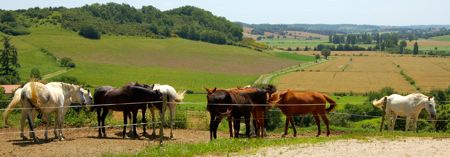
Horses behavior is formed by the fact that they naturally live with each other 24/7 (unless they are kept in solitary confinement which is a whole other question). They eat, sleep, groom and shelter together, as well as the fact that they are with their own kind. Humans cannot hope to replicate that relationship, and we don't need to. The relationship we can make with a horse is of a different order, we bring our qualities and merge them with the horse's qualities. In this way we can be proud of our value and how we appreciate their value.
- We assume that horses living in what we consider to be a safe environment will accept it as such.
Most of the horses we work with are considered to be domesticated, but despite selective breeding for temperament and a close association with people in recent times, they have been wild animals for a very long time. The wild instincts which helped them survive are still there in modern horses and can be observed in domestic horse behavior.
These instincts include:
- Desire to avoid predators through continuous threat assimilation
- Desire to seek food and if necessary shelter
- Desire to form a herd and maintain herd integrity
- Desire to reproduce
Most horse owners can form a compromise with their horses regarding these desires. Providing a horse with food, shelter and company, controlling hormones and forming a relationship as a result of satisfying these desires all go a long way to gain a horse's trust.
One desire which is often ignored or misconstrued is the fundamental instinct innate to horse behavior for self-defense. The most likely reason we can't appreciate it is that we don't empathise with what frightens them or comprehend the extent of their anxiety about danger. We know we are safe (in general) but why should we assume they do?
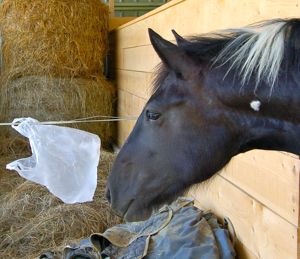
Assimilating a possible threat - an ever-present feature of horse behavior
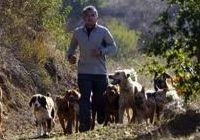
Dogs and humans have much more in common than human and horse behavior does, both being predator species, as well as living with one another. This is why being the pack leader is common sense for dog owners, and dogs will respond very well and be much calmer and happier if their owner assumes that role. Dog trainer Cesar Millan has an extraordinary intuitive understanding of this. The best way to tell if you are forming a trusting bond with any animal is by how much his or her personality is coming out. Ending up with an obedient robot may be convenient, but it doesn't give us a fulfilling connection with the other animal.
Seeing Horse Behavior From Their Point Of View
Human beings do have a sense of self-defense of course, we have also had our enemies and still do. The instinct for survival and self-protection is innate to all living beings.
Imagine being a horse born into the wild herd however - there is no door to lock at night or gun to load. No guard dogs or police. Ironically for most people the most dangerous species we have to worry about is ourselves, and not that many of us are worrying about an imminent attack. Horses in the wild in modern times are mainly only susceptible to the predation of their young, which is no less important of course, but the point is that they have only ever been creatures of defense. Throughout their evolution they have never hunted other animals. This means that their consciousness has always been devoted to or taken up to some degree, by threat awareness, evaluation and avoidance. This is an essential factor in understanding and addressing horse behavior.
They are constantly assessing the environment for danger.
When we began to domesticate horses and provide them with food and shelter, we also provided them with security. How do they know that they are safe with us though? We know that there are no lions in the hedges and wolf packs in the woods, but horses don't rationalize by thinking intellectual thoughts. Horses can't just listen to us when we tell them that they are safe from predators in our stables and fields. Horses only feel safe when they do what they have always done - assess their surroundings for potential danger and act on that.
As with any continuously evolving species, there will be some individuals born with a keener instinct for threat assimilation than others. Self-defense is still at the heart of modern horse behavior however, and few people seem to recognise it or manage it in a constructive way.
Some common misconceptions about horses which are attempting to assess surrounding threat:
- He is trying to get out of working
- She is being silly
- He is only a grazing animal and work does not come naturally, so he wants to distract himself from it
- She always spooks at things because she is high-spirited
- He has a short concentration span because he's young
Another way to look at it might be:
- He or she has left the herd, or companion-which-substitutes-for-the-herd, and is therefore highly vulnerable. They are then taken to a different environment than where they normally forage and shelter and are therefore exposed to any kind of potential danger(s), sadly including the human being who has taken them there.
In this situation what would you want to do if you were a horse?
- Probably take some time to have a look round and check out the situation. This is exactly what most horses are not allowed to do. Whether they are pushed, pulled, tapped or encouraged with voice aids to 'go forward', more or less forcefully, makes no difference - they are not being allowed to do the one thing that will reassure and calm them, and allow them to turn their attention back to you.
This is one of the main ways that humans misinterpret horse behavior, and as a result, cause tension right from the start of the training process.
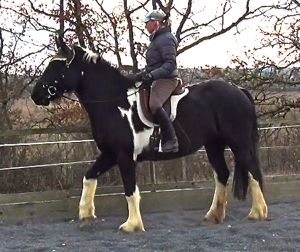
This young horse has perceived a possible threat outside of the arena. Her rider is giving her the time to evaluate it, thus maintaining a trusting partnership.
Typical Threat-Evaluation Horse Behavior and How to Manage It
Step 1: The first thing we can do to help our horse is to relax and stop worrying about all the training goals and plans we have for today's riding session.
Think about it this way, we can only do valuable work with a calm horse, and the horse will only be calm if we can allow them to relax, so patience is not only a plus, it is a necessity. Pushing on past all of these issues might seem to save time, but in fact we are only running past the entrance to the pathway where we can mutually connect with our horse, not just have a one-way conversation while the horse recedes further and further away from us. Because this is what happens if we deny the horse the chance to evaluate threat in peace. It is a phenomenon called dissociation which is a symptom of traumatisation.
If you are prepared to relax, then in the horse's mind, you have already assessed the threat of your current situation to be negligible, and depending on how much your horse already trusts you, this will influence his own assessment. If you can follow these steps and appreciate how horse behavior works you are likely to be able to form enough trust over time that your opinion is enough, and the horse will be liberated to concentrate on you for the entire time you are together. If you are also respecting your horse's boundaries in his work then his work will become a time of freedom from threat and eventually a physical pleasure, and he will be disappointed to miss it.
Step 2: Stay tuned-in to your horse's awareness.
Become aware of your horse's behavior on a more subtle level: notice whether she is alert and listening to you, or if she is watching the world around her. Also notice if she doesn't seem to be listening to anything, but is instead directing her awareness inside herself. If she does this try to work out when it began during the session i.e. whether she is like that all the time or only when you produce the saddle, or maybe when she catches sight of the arena. Horses dissociate very easily from situations they have been traumatised by in the past.
Step 3: If your horse directs his attention away from you and both ears are pointing away, then he is assessing a threat.
To help you be patient you can try to see what he is observing or hearing or even smelling, yourself, and imagine what it would be like to have to check for danger all the time as natural horse behavior dictates - like the heightened awareness of danger of a parent for their children.
Wait, without distracting him in any way, until he is satisfied the threat will not materialize. Usually he will tell you this by revolving an ear round in your direction. This is the most reliable signal, sometimes his attention will shift and he will seem to shrug and come back to you. It is only fair to make a demand on him at this point because when he is still evaluating the threat he can't listen to you too. If you reassure him when he is evaluating the threat this will only distract him. When you give him full responsibility at first, he will be able to gradually let it go more completely because he will know you understand the importance of threat to him.
Step 4: If the horse perceives the threat as dangerous then she will spend longer analyzing it, and perhaps consider turning round to run away.
Of course if the threat is perceived by the horse as imminent then the flight response may be almost immediate! In between the analysis and the running however, there is usually a moment when she will cast her attention in your direction, and in this hesitation you have your chance to 'steady the ship' and keep her facing the threat. Try to do this in as non-forceful a way as possible: if you are riding, using your legs and postural strength in preference to holding onto the bit.
If she is then allowed to assess it again and is supported each time she continues to try to turn away, then eventually she will accept that she is not in danger. In this scenario she might even wish to walk closer to see it better. Allow this, because until she accepts that the object or event is not a threat, she will not relax and be able to concentrate on her work.
The following photo's illustrate this process. This horse recently went through a period in her training where she was almost constantly perceiving threat outside the arena during her schooling session. This came about because she had previously been worked in a state of extreme tension, and part of her process of releasing it was for her to manifest this tension externally as perceived danger in her environment, and be given sufficient time to evaluate it so that she could finally see the arena as a safe place, and trust the leadership of her rider.
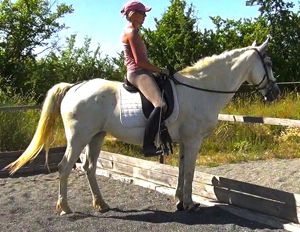
1) Threat assessment
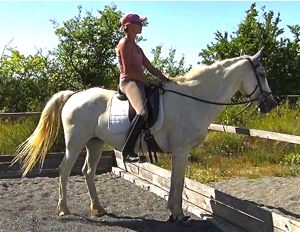
2) Ear back to rider, and reassurance stroke
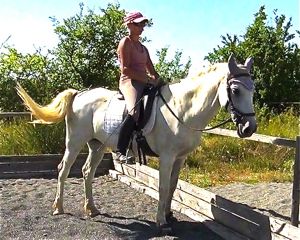
3) Asking her to go forward again
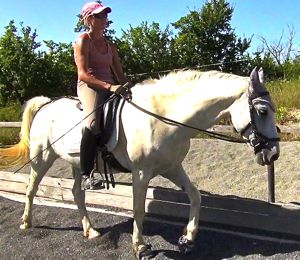
4) Relaxed and listening, ready to work
What To Expect When You Begin To Interpret Horse Behavior From The Prey Animal Perspective
Each horse has his innate outlook and he also has his previous life experience. One influences the other to produce individual horse behavior, and when you begin to respect his perspective you are sure to learn far more about him.
- Horses which have been refused the chance to satisfy their threat anxiety in the past might go into a kind of threat assessment frenzy, wanting to stop and look every few minutes (as in the example above), or for long periods of time, especially in places they have felt particularly unsafe. This is rehabilitation work, and if you can see it through you will heal long-held traumas and release deeply suppressed emotions. Notice whether the horse feels 'safer' than usual in between pauses, or more supple and able to stretch and swing more.
Gradually the first wave will stabilize and pauses will be less frequent. Horses like this will be helped if you can add reassurance at the point when they turn to you for your opinion. Scratch at the withers or gently stroke the neck and speak in a low affectionate voice. Adding extra security to the horse's own satisfaction that the world is safe at that moment will encourage him to rate your leadership qualities.
- Chronically dissociated horses may be completely switched-off to the world around them. This is not the same as being relaxed. You will know the difference by how well you know your horse's personality. If he or she doesn't seem to have one then this is not because they don't, it is because they are traumatised and have withdrawn to a place inside themselves where they don't have to acknowledge what is around them.
Some horses undergoing certain natural horsemanship techniques are particularly good examples of this distortion of natural horse behavior. They appear to accept everything which is done to them or with them, but they are as 'present' as a mechanical robot. Such a horse is a challenge to rehabilitate, but when they come back out again you will feel such a sense of joy it is incomparable with much else. They may need some time in a herd with their own kind and much time in the company of people who simply want to be gentle with them - they will choose their path. It is never too late to help that spark ignite again.
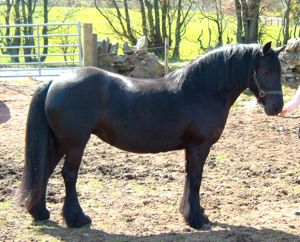
Meg came to us from a riding school, and we gave had a year out with the herd before we brought her back into work. Her contact with people was only to be fed and rugs changed, she was traumatized about her feet being trimmed so we didn't push this at first. After a while she began to realize she was in a different life and her personality started to come out. She was a shy horse with people, and almost over-sensitive, although with other horses she could certainly stand her ground! She did balance out more emotionally over many years.
- Dominant horse behavior often translates into the need in those type of horses to insist on their danger evaluation more forcefully. This is because they naturally relinquish responsibility less easily, whether their dominance stems from insecurity or self-confidence. They are herd leaders and will be less easily convinced to let the position go. In this case patience is just as important as for traumatized horses. you can only take control if you are given it, and only the horse can give you responsibility for his life.
- If you can be fairly consistent, you will notice the periods between threat assessments decrease until they are very rare. Whenever they do surface, always react in the same way. The horse will always be a prey animal, and if you are always willing to appreciate that then they will very rarely resort to flight tactics. Unpredictable and dangerous horse behavior is often partly due to the rider's refusal to give the horse time to assimilate his surroundings and accept his situation.
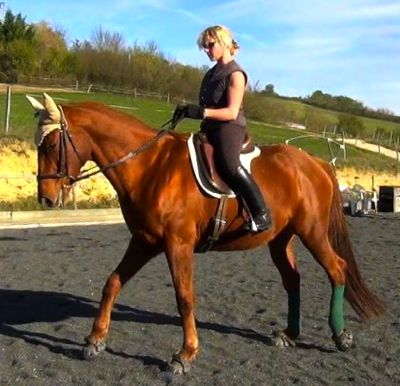
Hope is an example of how it is possible to regain a horse's trust at the deepest level. She had reached a meltdown in her relationship with people, she reared and refused to go forward under saddle. Listening to her needs and allowing her to judge her own safety resulted in such a radical turnaround that she came to feel her work was her safe place, and it would take a hot air balloon landing in the arena to make her worry!
The pages on HHT are so wide-ranging and interrelated that we strongly recommend you look at the site plan to find other subjects that may interest you, however here are some pages directly related to Horse Behavior:
Horse Herd Behavior
Horse Personality Dynamics
Horse Behavioral Problems
return from Horse Behavior to Happy Horse Training homepage
The pages on HHT are so wide-ranging and interrelated that we strongly recommend you look at the site plan to find other subjects that may interest you.
New from HHT!
AudioRide is a series of exercises designed to listen to while you ride.
Audio descriptions guide you through each step of developing a balanced, dynamic connection with the horse through your position.
This truly innovative learning tool gives you a whole new way of being guided in your riding, in a calm, clear, step-by-step way.
Free Download! Introductory Exercise: Riding in the Now
The Gymnastic Rider eBook
Now available exclusively from HHT!
A unique, comprehensive guide to practical rider biomechanics. This professionally produced eBook takes the rider through the process of developing their body in the specific way that brings the horse's movement into harmony and balance, without force and constraint. Click here for full details, and to download the 15-page introduction to the book for free.
Join the Happy Horse Training group on Facebook!
See and share topical info, news and photo's, and take part in lively discussions.
Click here to go to the HHT group (make sure you log into fb first) and then click on the 'join' button at the top of the page.
Join the Whole Horse Newsletter!
HHT's free monthly newsletter giving you wide-ranging and intelligent insights into holistic horsemanship.
Just enter your details below to join.
Free bonus on the riding position with all new subscriptions: Ten Top Tips To Instantly Improve Your Connection With Your Horse.
Click here to see back issues of The Whole Horse newsletter
Train Your Horse
The Holistic Way
How To Train A Horse Without Force
is a unique guide to training horses through energetic connection and
gymnastic training. Part 1 covers everything on the ground, from
handling to the lungeing technique that develops strength, straightness
and engagement. Comes with a free eBook supplement on Horse Trauma.
Click here for more details.
"As a student of Zen Buddhism for nearly three decades, I've often wondered when someone was going to write the book on Zen and the art of horsemanship, and I think that your emphasis on mindfulness and energy connection gets right at the heart of the matter."
- Prof. Teresa Lloyd, U.S.
Do You Have
A Horse Story
To Share On HHT?
So many people have been through
wonderful experiences with horses, whether in training or otherwise. If
you've made a change in a horse's life - or one has made a change in
yours - tell us about it here.
Learn The Natural Barefoot Trim - The Simple Way
The Simple Seven-Step Natural Trim is a comprehensive step-by-step guide to a cutting-edge barefoot trim. Click here to find out more.
What people say about HHT:
"The riding instruction is outstanding, if instructors in the UK taught this way there would be a lot of happy riders and horses."
"The riding tuition exceeded my hopes and expectations by a long way; giving me an exciting new facet to horsemanship which is lighter. more subtle, more elegant and more meaningful. It is as if a new door has opened bringing more sunlight and air."
"My goodness - what a change has taken place in my riding. I think that I'm starting to sit 'into' the horse rather than on top of him. I felt my horse's movements in a way that has almost never happened before"
Click on Testimonials for more





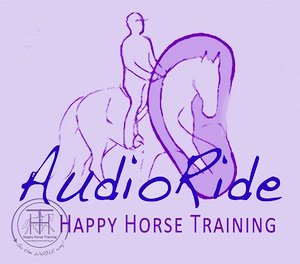




New! Comments
Anything to say about this page? Leave your comment in the box below.